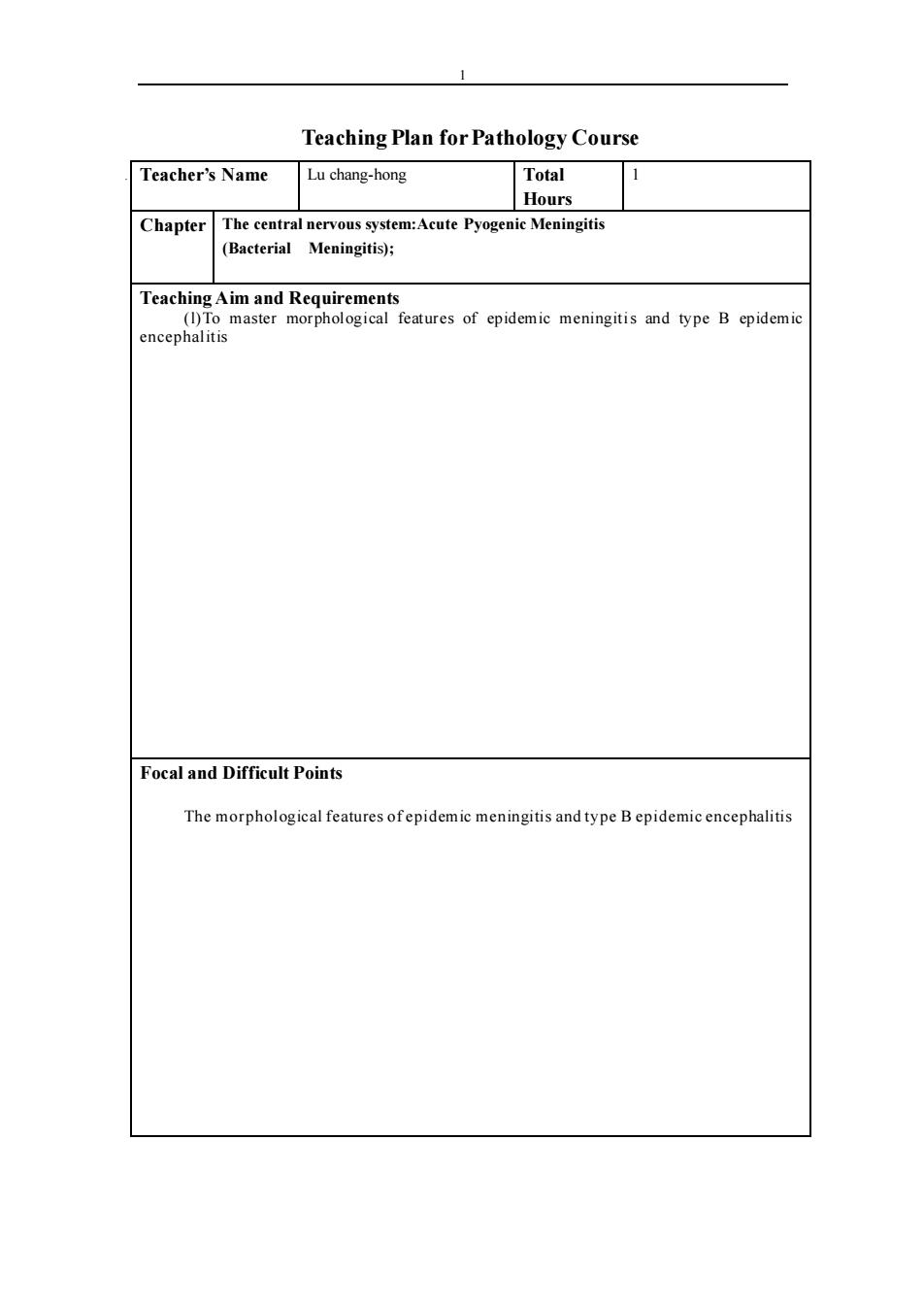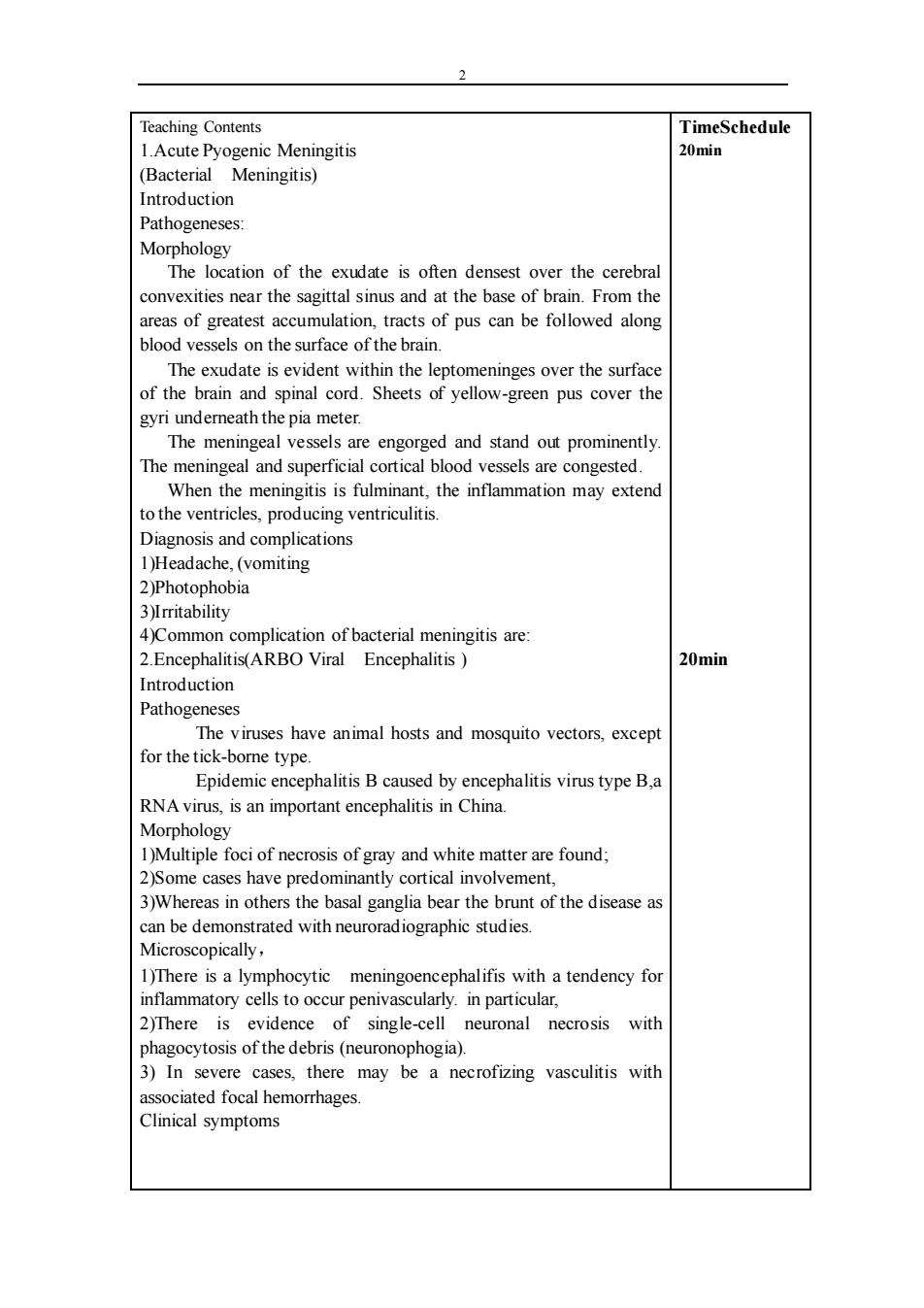
Teaching Plan for Pathology Course Teacher's Name Lu chang-hong Total Hours Chapter The central nervous system:Acute Pyogenie Meningitis (Bacterial Meningitis); Teaching Aim and Requirements master morphological feaures of epidemic meningitis and type B epidemic encepha Focal and Difficult Points The morphological features ofepidemic meningitis and type Bepidemicencephalitis
1 Teaching Plan for Pathology Course Teacher’s Name Lu chang-hong Total Hours 1 Chapter The central nervous system:Acute Pyogenic Meningitis (Bacterial Meningitis); Teaching Aim and Requirements (l)To master morphological features of epidemic meningitis and type B epidemic encephalitis Focal and Difficult Points The morphological features of epidemic meningitis and type B epidemic encephalitis

Teachine Contents TimeSchedule 20min (Bacterial Introduction Pathogeneses Morphology The location of the exudate is often densest over the cerebral convexities near the sagittal sinus and at the base of brain.From the areas of greatest accumulation,tracts of pus can be followed along blood vessels on the surface of the brain. The exudate is evident within the leptomeninges over the surface of the brain and spinal cord.Sheets of yellow-green pus cover the gyri undemeath the pia meter The meningeal vessels are engorged and stand out prominently. The meningeal and superficial cortical blood vessels are congested. When the meningitis is fulminant,the inflammation may extend to the ventricles,producing ventriculitis. 2)Photophobia 3)Irritability 4)Common complication of bacterial meningitis are: 2.Encephalitis(ARBO Viral Encephalitis) 20min Introduction Pathogeneses The viruses have animal hosts and mosquito vectors,except for the tick-borne type. Epidemic encephalitis B caused by encephalitis virus type B.a RNAvirus,is an important encephalitis in China Morphology 1)Multiple foci of necrosis of gray and white matter are found; 2)Some cases have predominantly cortical involvement, 3)Whereas in others the basal ganglia bear the brunt of the disease as can be demonstrated with neuroradiographic studies Microscopically, 1)There is a lymphocytic meningoencephalifis with a tendency for inflammatory cells to occur penivascularly.in particular, 2)There is evidence of single-cell neuronal necrosis with phagocytosis of the debris(neur ophogia). 3)In severe cases,there may be a necrofizing vasculitis with associated focal hemorrhages. Clinical symptoms
2 Teaching Contents 1.Acute Pyogenic Meningitis (Bacterial Meningitis) Introduction Pathogeneses: Morphology The location of the exudate is often densest over the cerebral convexities near the sagittal sinus and at the base of brain. From the areas of greatest accumulation, tracts of pus can be followed along blood vessels on the surface of the brain. The exudate is evident within the leptomeninges over the surface of the brain and spinal cord. Sheets of yellow-green pus cover the gyri underneath the pia meter. The meningeal vessels are engorged and stand out prominently. The meningeal and superficial cortical blood vessels are congested. When the meningitis is fulminant, the inflammation may extend to the ventricles, producing ventriculitis. Diagnosis and complications 1)Headache, (vomiting 2)Photophobia 3)Irritability 4)Common complication of bacterial meningitis are: 2.Encephalitis(ARBO Viral Encephalitis ) Introduction Pathogeneses The viruses have animal hosts and mosquito vectors, except for the tick-borne type. Epidemic encephalitis B caused by encephalitis virus type B,a RNA virus, is an important encephalitis in China. Morphology 1)Multiple foci of necrosis of gray and white matter are found; 2)Some cases have predominantly cortical involvement, 3)Whereas in others the basal ganglia bear the brunt of the disease as can be demonstrated with neuroradiographic studies. Microscopically, 1)There is a lymphocytic meningoencephalifis with a tendency for inflammatory cells to occur penivascularly. in particular, 2)There is evidence of single-cell neuronal necrosis with phagocytosis of the debris (neuronophogia). 3) In severe cases, there may be a necrofizing vasculitis with associated focal hemorrhages. Clinical symptoms TimeSchedule 20min 20min

Teaching Methods Multimedia and explanations
3 Teaching Methods Multimedia and explanations